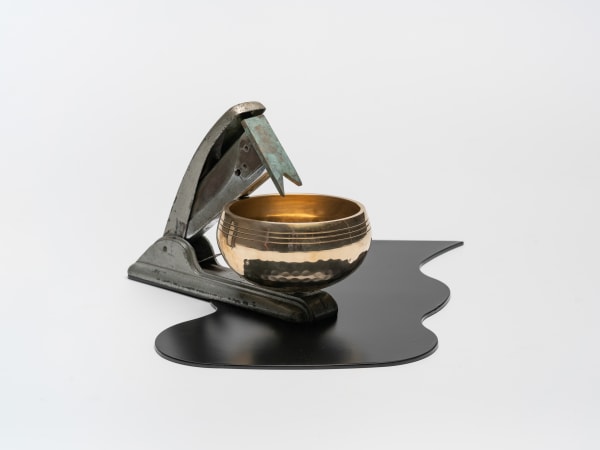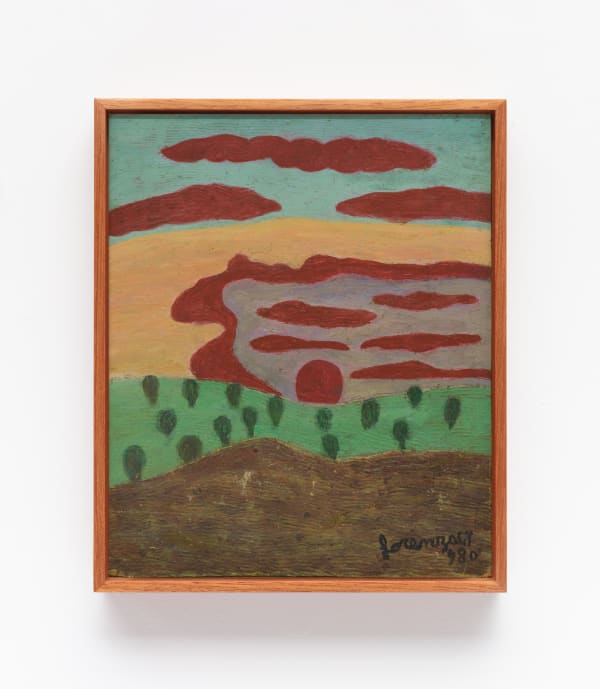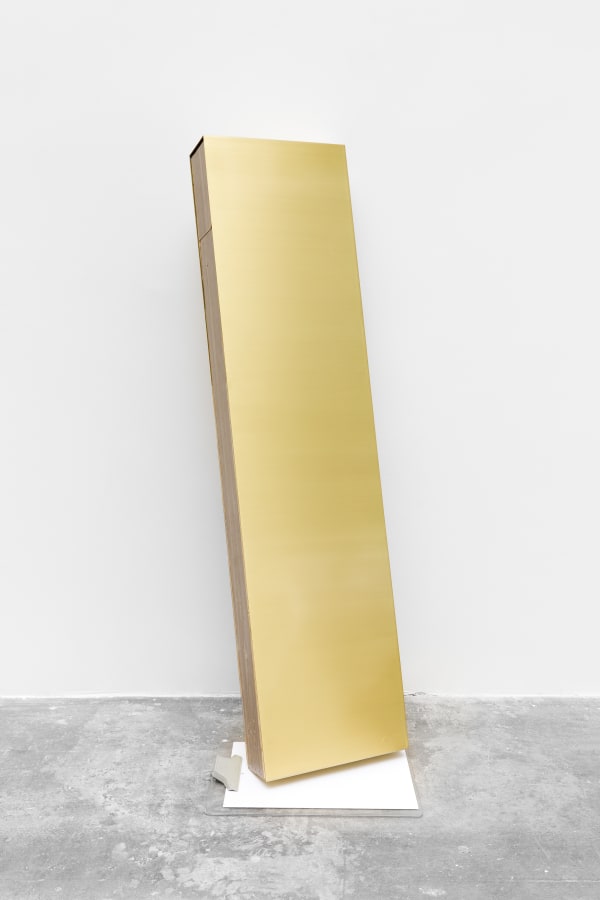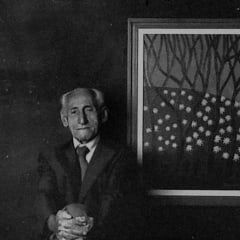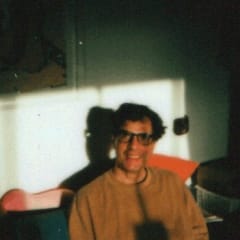Mendes Wood DM: Germantown Art and Design Week
For the occasion of Germantown Art and Design Week, Mendes Wood DM Archipelago presents to the public a selection of works, bringing together icons of Brazilian modernist design and architecture in dialogue with contemporary designers and artists. Design classics are set against a curated selection of artworks from the Mendes Wood DM program and Hudson Valley-based artists. Germantown-based Katie Stout presents ceramics alongside artists who blur boundaries between sculpture and functional objects.
Upon entering Archipelago’s Church Avenue space, guests are greeted by a 1972 Oscar Niemeyer leather and chrome-plated steel lounge chair and a photograph by Paulo Nazareth depicting abandoned couches in an arid landscape. Behind this stately chair, Andrew De Freitas’s solid imbuia chair (2024) echoes the lines of a Jorge Zalszupin rosewood coffee table crafted half a century earlier, emphasizing a sense of creative continuity between the two.
Kelly Wearstler’s hand-carved stool, sculpted from a single block of wood, stands alongside Italian-born Brazilian modernist Lina Bo Bardi’s iconic 1980 Cadeira Sesc Pompéia stool. Both pieces explore innate qualities within natural materials, emphasizing raw forms and tactile appeal across eras and approaches to craftsmanship. Adriano Costa’s Cracked Secretary (2023), composed of bronze on wood, clipboard, and paper, frames the doorway to the adjacent room; the gilded, precarious sculpture juxtaposes the architectural determination of Lina Bo Bardi’s piece. Nearby, the mahogany outline of a Sergio Rodrigues mirror complements the rich black walnut used in Brecht Wright Gander’s intricate table Directions for Knowing All Dark Things (2024). The visual and tactile amalgamation is inlaid with an extraordinary array of materials: mother of pearl, brass, assorted shells, kirinite, acrylic, lacewood, lazurite, pāua shell, purpleheart, pink conch shell, turquoise, wenge, padouk, and yellow stone.
In the dining room, two paintings by Paula Siebra are exhibited: Pé de Jambo (2024), depicting a jambo tree heavy with fruit, and Vista do Rio Hudson (2024), painted during the artist’s recent residency in Germantown. Nearby stands Kieran Kinsella’s stool, Shaggy Beast (2024); crafted from charred oak, its textured surface and organic form break the mold with conventional furniture aesthetics. In the center of the room and in seeming equal dialogue with the “institution,” O Escritório [The Office] (2021), a bronze sculpture by Adriano Costa, rests atop a dining table by Carlo Hauner and Martin Eisler. The duo, who emigrated to Brazil to flee fascism in Europe, met in São Paulo in the early 1950s and founded the innovative Forma studio, crafting iconic designs from native Brazilian woods, engaging in perpetual interplay between European and Brazilian tropes and sensibilities.
Hauner and Eisler’s works, like many from the exhibition’s ensemble of Brazilian furniture, invite contemplation on transatlantic exchanges and perceptions of history and futurism. The selection spans bold interpretations of office furniture to more abstract reflections, such as Pedro Ávila’s uncanny contemporary studies on the sculptural nature of objects. Often asymmetrical and minimal, Ávila’s pieces channel the aesthetics of Brasília, drawing from brutalism and Oscar Niemeyer’s organic, curved forms, forwarding shapes that appear almost wind-swept or in a state of molten flow.
At first glance, the works of Estúdio Rain’s Rícino series appear to be paintings. In fact, they are lamps made from plant-based castor oil resin and aluminum. The ethereal lamps highlight the living aspect of the material, emphasizing both aesthetic and technical qualities. Meanwhile, flanking the dining table are Rafael Triboli’s Folding Screen (2024), crafted from solid wood, carnauba wax, and brass, and a 1950s floor lamp by Enrico Furio Dominici, featuring a painted brass base and aluminum dome.
Displayed in the stairwell to the lower level, Brazilian-born LA-based ceramicist Cecilia Tanure enters the conversation through uniquely textured vases that evoke endlessly intricate macrocosmic and microcosmic landscapes. The lower level’s 1770 stone hearth and slate walls reveal the age of the structure. These signs of the home’s origins serve as a backdrop to Hudson Valley contributors who straddle the borders of utility and aesthetics through their refined mastery of material and technique. Sylvia Estes’s Hourglass (2024) lamp hangs by the window. Crafted from cardboard, newspaper, tissue paper, aluminum can, papier-mâché, and gesso, the lamp converses with cultures of consumption and disposability. Estes’s work asserts that artfulness exists even in the refuse of daily life, offering a counterpoint to a world often saturated with anthropogenic debris. Ceramicist Ori Carlin’s shell-like creations, seemingly inspired by aquatic life, offer an approach to crafting objects informed by synchronous, harmonizing shapes found in nature. Similarly, Mike White forwards connections to the natural world – in his practice, through the use of marble, frosted glass, borosilicate glass, and vegetable-tanned leather. White’s exploration of columns can be juxtaposed with Lucía Reissig’s approach to cylindrical forms expressed, here, through her leathery, waxy latex Evitas.
Adjacent to the house , the Germantown-based artist Katie Stout exhibits her intricately sculpted Vessels in a space typically serving as a studio for artists in residence. The studio has been transformed to house new pieces by Stout, whose extraordinary expression of traditional craft techniques offers sharp critiques of outdated norms relating to decorative arts to gender roles. Her works are shaped by an urge to subvert utilitarian forms just past the threshold of comfortability and the intention to peel back layers of seriousness often associated with design. Stout uses traditional materials to create non-traditional forms, displaying polychromatic, florescent vesselsexpressive of organic complexity while pushing the boundaries of function from dualities like “vase” and “flower.”
Also featured across Archipelago are works by Alma Allen, Maria Auxiliadora, Sonia Gomes, Amadeo Luciano Lorenzato, Tshidi Malale, Solange Pessoa, and Marcos Siqueira, alongside an installation of foraged florals by Rae Wilson.
-
 Alma Allen, Untitled, 2023
Alma Allen, Untitled, 2023 -
 Oscar Niemeyer, Lounge chair and ottoman, 1972
Oscar Niemeyer, Lounge chair and ottoman, 1972 -
 Paulo Monteiro, Untitled, 2024
Paulo Monteiro, Untitled, 2024 -
![Paulo Nazareth, [Mestre Paulo] Cachorro magro, 2023](data:image/gif;base64,R0lGODlhAQABAIAAAAAAAP///yH5BAEAAAAALAAAAAABAAEAAAIBRAA7) Paulo Nazareth, [Mestre Paulo] Cachorro magro, 2023
Paulo Nazareth, [Mestre Paulo] Cachorro magro, 2023 -
 Paulo Nazareth, Don’t Worry, 2011
Paulo Nazareth, Don’t Worry, 2011 -
 Adriano Costa, O Escritório, 2021
Adriano Costa, O Escritório, 2021 -
 Joaquim Tenreiro, Bibliothèque basse, 1960
Joaquim Tenreiro, Bibliothèque basse, 1960 -
 Amadeo Luciano Lorenzato, Untitled | Sem título, 1980
Amadeo Luciano Lorenzato, Untitled | Sem título, 1980 -
 Adriano Costa, cracked secretary, 2023
Adriano Costa, cracked secretary, 2023




![Paulo Nazareth, [Mestre Paulo] Cachorro magro, 2023](https://artlogic-res.cloudinary.com/w_600,c_limit,f_auto,fl_lossy,q_auto,dpr_auto/artlogicstorage/mendeswooddm/images/view/a60b1b1703a93563952c4ee5477717efj/mendeswooddm-paulo-nazareth-mestre-paulo-cachorro-magro-2023.jpg)

